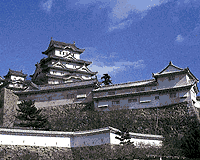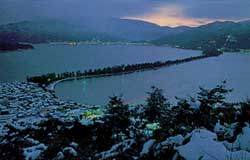Kinki Region: Northern Kinki
Kinki Region: Kyoto | Osaka & Kobe | Nara | Northern Kinki | Kii Peninsula
The northern Kinki Area is made up of Hyogo Prefecture to the west, the north of Kyoto Prefecture, and Shiga Prefecture, with Lake Biwa at its center. It includes some of the countries most scenic spots and is well worth a visit for anyone who has seen the attractions of the major cities in the area and still has time for more.

Himeji Castle

Amano-hashidate on a winter evening
Himeji
Himeji is best known for its majestic castle, located in the city center and considered the best surviving feudal castle in Japan. It is also known as Shirasagi-jo (White Egret Castle) because of the resemblance of its white-plastered walls to the bird's silhouette. Situated on a 45m-high hill, the building was started in the mid-14th century, expanded by warlord Toyotomi Hideyoshi and completed in 1609 by daimyo (baron) Ikeda Terumasa, a supporter of shogun Tokugawa Ieyasu. It was second only to Osaka Castle in size. It is made up of a 5-story donjon (main keep), three 3-story donjon and a series of interconnecting passageways. The main compound is surrounded by three rings of outer compounds. The grounds have been designated as a Historic Site and the castle itself as a National Treasure. The Shirasagi-jo is a classic example of Japanese castle design, with an almost impenetrable defense system. But it was built at the beginning of the peaceful Edo Period (1600-1868) and was never actually attacked. It was used as an administrative center and symbol of power. The Kurosawa Akira film Ran includes scenes where a castle is under attack and gives some idea of the inside of one of these fortresses. Enkyoji temple at the summit of Mt. Shosha on the outskirts of the city attracts visitors and has a good view of the city below.
Amano-hashidate
This is a 2-mile long sandbar that separates Miyazu Bay from the Asokai lagoon in the north of Kyoto Prefecture. Along with Itsukushima in Hiroshima and Matsushima in Miyagi Prefecture, it is one of the Nihon Sankei, or 'three most famous views in Japan'. Lined with a thick grove of gnarled pine trees, the sandbar is only 15m wide at its narrowest point. The name of the sandbar means 'bridge to heaven' - the myth tells of a ladder between heaven and earth used by a god to visit his earthly lover which collapsed to create the sandbar. One of the best views is from Kasamatsu Park, on a hill at the north end of the bay. The tradition is to look between your legs down the hill and the 'bridge' seems to float toward the heavens. The nearest city is Miyazu, which is a handy place to stay if you don't feel like the 2-hour 20-minute train journey to Kyoto. It has a late-19th century pink wooden church as well as a few Edo Period (1600-1868) buildings.
Lake Biwa
Just 10km to the east of central Kyoto is the southern end of Lake Biwa. At 672 sq km, it is the largest freshwater lake in Japan. It is divided into the average-50m-deep North Lake and the 5m-deep South Lake. It provides water to the Kansai region cities of Osaka, Kobe and Kyoto and takes up much of central Shiga Prefecture. Shiga was formerly known as Omi and the famous Omi Hakkei are eight scenic spots on the shores of the lake. The scenes were the described in a poem written in 1500 and include Descending Geese at Katata (Katata no Rakugan), the subject of an 1830 ukiyo-e (woodblock print) by Ando Hiroshige. This print includes the Ukimido, a Buddha hall of the Mangetsuji temple, which stands serenely above the waters of the lake. The city of Hikone, on the east shore, has one of Japan's few surviving feudal castles, which is set in the beautiful Genkyuen garden and overlooks the lake.
About 20km northeast of Hikone is the town of Sekigahara, scene of one of the most famous battles in Japanese history. In 1600, the daimyo (barons) were engaged in a struggle to to fill the vaccuum left by the death of warlord Toyotomi Hideyoshi two years before. An army from the west, led by Ishida Mitsunari, and one from the east, led by Tokugawa Ieyasu - over 100,000 men in all - deployed just west of the town on the night of October 20th. Thanks in part to the defection of some of the western daimyo when the fighting commenced the next morning, Ieyasu won the battle and the almost 300-year reign of the Tokugawa Shogunate began.
Related content
- See our page on the official websites for each prefecture and major city: Guide to Japan's Regions and Cities
